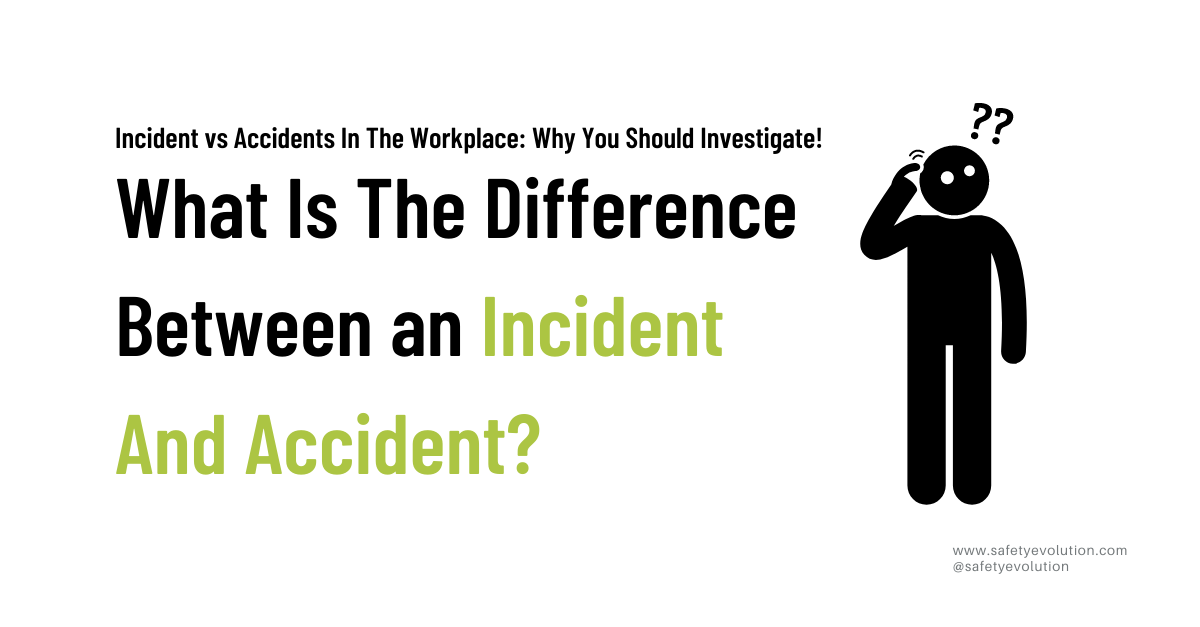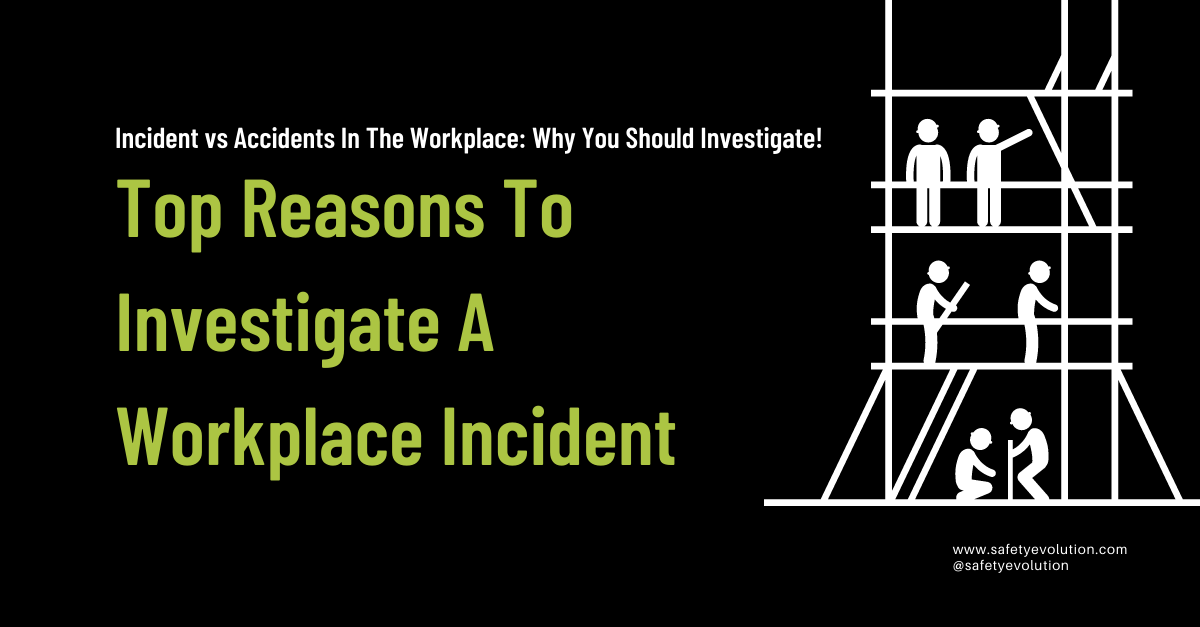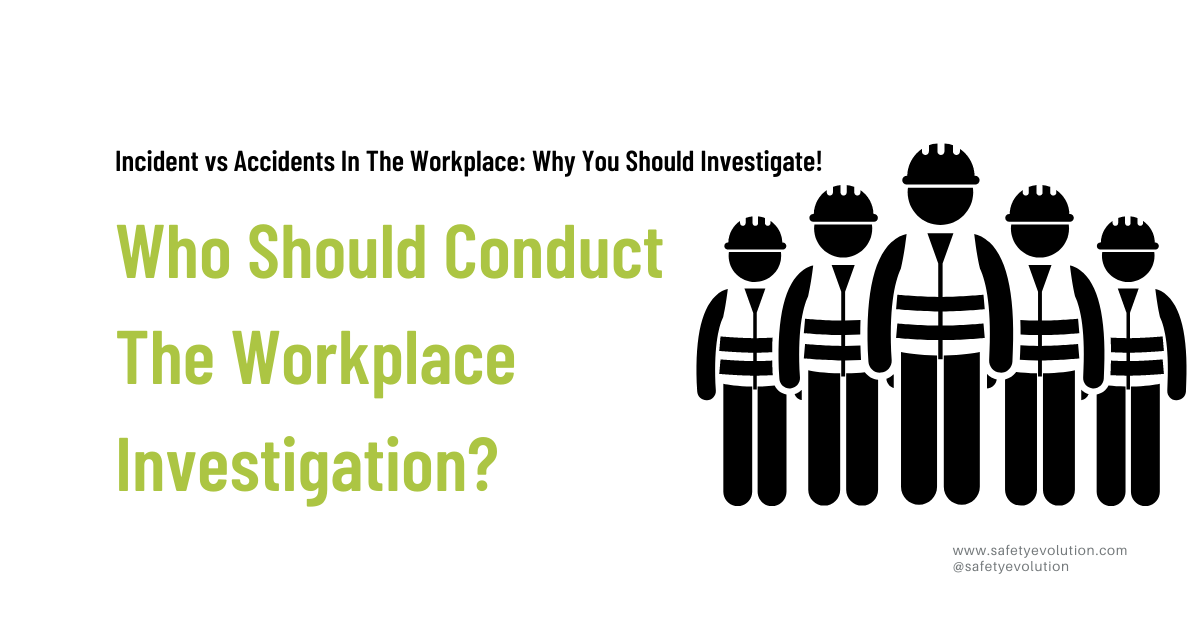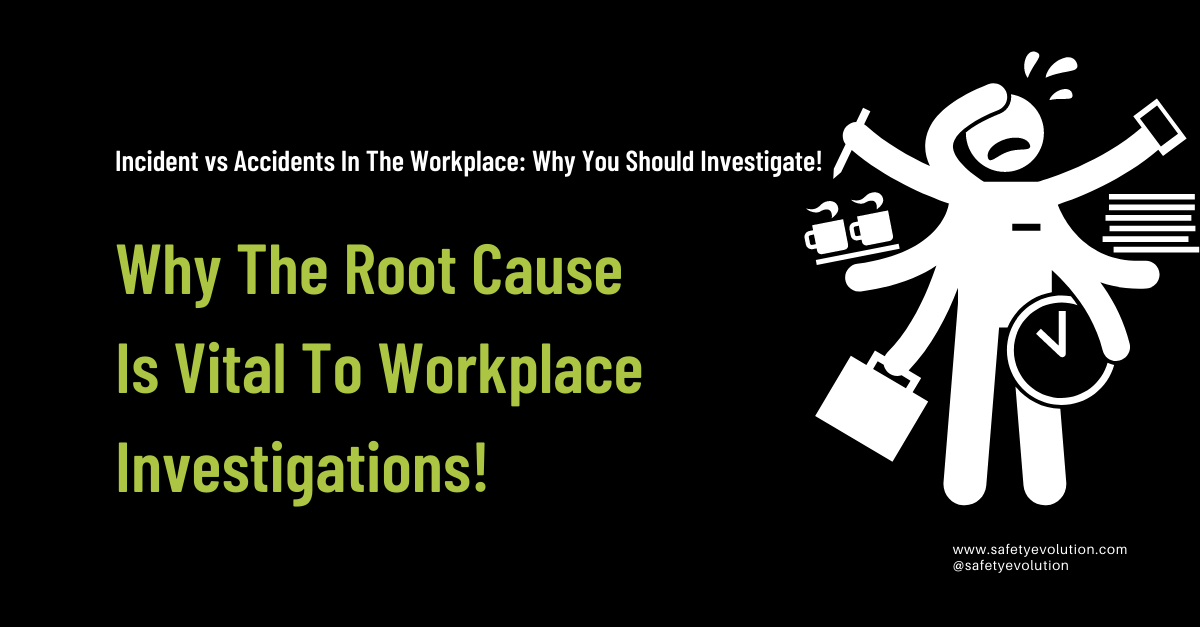Everyone comes to their workplace with the expectation, and often a clear plan, for an incident/accident-free day. And many times the day goes just as planned.
Until it doesn’t! The “unexpected” happens! Someone or something is in the wrong place at the wrong time. At that moment, perhaps only a split second, an incident or accident takes place.
Should it be reported? Should it be investigated? The answer to both questions is a resounding YES!
To better understand the importance of accident/incident investigation, let’s dig deeper into the “WHY” question...
- WHY should accidents and incidents, no matter how small, be reported?
- WHY we should investigate, and finally
- WHY did this event happen? How can we prevent it from happening again?

What Is The Difference Between an Incident And Accident?
“Accident” or “Incident”? You may have heard these terms used interchangeably at your workplace. Or perhaps each refers to a separate type of event. Let’s look at how CCOHS, the Canadian Center for Occupational Health and Safety, defines these terms.
Incident definition:
An occurrence, condition, or situation arising in the course of work that resulted in or could have resulted in injuries, illnesses, damage to health, or fatalities.
Accident definition:
An unplanned event that interrupts the completion of an activity, and that may (or may not) include injury or property damage.
Pretty close to the same thing, you may say. And a bit confusing, as well! To avoid confusion, we are going to move away from the term “accident”.
Here’s why. “Accident”, implies that “fate or chance” is involved. When the root cause of an event is examined, it is usually determined that the event was predictable and could have been prevented.
As we discuss “Incidents”, remember, we are including those that cause harm or damage and those “WOW, that was close” moments known as Near-misses. Reporting and investigating both are equally important!
Here’s why.

Top Reasons To Investigate A Workplace Incident
Reporting and investigating workplace incidents is a valuable tool for developing your company's Safety Management System. As your company continues to look for ways to improve workplace safety, encourage all your workers to report every incident, even the minor ones! This practice will play a huge part in building a proactive safety program and a positive safety culture.
What are the “WHYs” for reporting and investigating incidents?
Most importantly, by conducting an investigation we find out the cause of incidents and prevent similar incidents in the future. As a result,
- The workplace becomes safer,
- Management commitment to safety is reinforced
- Worker buy-in to the safety program increases.
Investigations provide your management with valuable information for the day-to-day operation of the company such as:
- Fulfills any legal requirements
- Determines the cost of an incident
- Determines compliance with applicable regulations (e.g., occupational health and safety, criminal, etc.)
- Processing workers' compensation claims

Who Should Conduct The Workplace Investigation Process?
Who is involved in the investigation can impact the information gathered and therefore, the end results. The priority is getting the best possible picture of what really happened and how future recurrence can be avoided.
Remember, workplace investigations are about prevention not finding fault! Start to build confidence in the incident reporting and investigation process by including input from as many sources within the company as possible.
Start off by determining who is best qualified to conduct the workplace investigation. Will the investigation be conducted by an individual or by a group?
Ensure that, whether individually or collectively, the following skills and experience are included:
- experienced in incident causation models,
- experienced in investigative techniques,
- knowledgeable of any legal or organizational requirements,
- knowledgeable in occupational health and safety fundamentals,
- knowledgeable in the work processes, procedures, persons, and industrial relations environment for that particular situation,
- able to use interview and other person-to-person techniques effectively (such as mediation or conflict resolution),
- knowledgeable of requirements for documents, records, and data collection; and
- able to analyze the data gathered to determine findings and reach recommendations.
The severity of the incident will usually dictate the resources and personnel involved such as:
- Safety advisors and Safety Coordinator
- Union representatives, if applicable
- Members of your Joint Health and Safety Committee or Safety Representative
- The “boots on the ground” supervisors and workers offer a valuable perspective when assessing the causal factors and determining corrective actions. Encouraging input from your worker provides your company with a complete picture of the incident. The overall connection with safety increases as more value is placed on worker involvement in the investigation process.
- In the case of serious workplace incidents, you may bring in “outside” experts or be required to involve local government, the police or WCB. Be sure to have a plan in place to coordinate the involvement of these authorities.

Why The Root Cause Is Vital To Workplace Investigations
Now you have gathered all your data and have a clear picture of what took place. Getting to the bottom of the “WHY” is the next step!
What is the “root cause” and how is it determined? What are other “causal factors” and how do they play into the incident?
Root Cause:
A factor that caused a nonconformance and should be permanently eliminated through process improvement. The primary driver of the event.
Causal Factors:
These are the secondary drivers of the event..the unintended contributors to an incident “ that if eliminated would have either prevented the occurrence of the incident or reduced its severity or frequency”. Finding the causal factors often takes digging down and looking beyond the obvious.
Even the most simple and straightforward incidents rarely have one single cause. The most successful investigations require moving away from “tunnel vision”. Examine all the possible causes and, using the information gathered, ask questions…lots of questions. And when you are done… ask more questions!
- Was the worker distracted? If yes, why was the worker distracted?
- Was a safe work procedure being followed? If not, why not?
- Were safety devices in order? If not, why not?
- Was the worker trained? If not, why not?

What Steps To Follow In A Workplace Incident Investigation
When an incident occurs on the job site, time is of the essence. As little time as possible should be lost between the time of the incident and the beginning of the investigation.
The 3 key steps to conducting a successful investigation are Reporting, Investigation, and Action Plan!
Reporting:
- Reporting the incident
- Providing first aid or medical aid to the injured
- Secure the scene and take the necessary steps to prevent further damage or injury
When an incident occurs, remembering the necessary information to include in the Incident Report can be daunting. Digitized safety programs like Safety Evolution's safety software offers a reporting process that helps gather and submit all the necessary information seamlessly.
Investigation:
- Scene management and assessment ( ensure the site is safe for investors)
- Witness Management - provide support, encourage openness by not finding fault or blame, conduct interviews, and maintain the confidentiality of witness statements.
- Investigate and collect data including photos, diagrams, and recent inspections
- Analyze the data and identify the root causes
- Report the findings and supply recommendations.
Action Plan:
- Develop an action plan for the corrective actions coming out of the investigation
- Implement the plan by assigning actions, setting a time frame for completion, and conducting follow up
- Determine if the corrective actions are adequate and effective.
- Look for changes that could be made for the ongoing improvement of safety in your workplace.
Review the finding of the investigation with workers in toolbox talks or safety meetings. Encourage suggestions and input. It is rare that an event has never happened before. The causes and corrections of prior incidents can shed new light and increase the likelihood that the investigation will prevent similar incidents in the future.

Free Download: Incident & Investigation Guide
Conducting a thorough investigation can be daunting. Collecting the necessary documentation and information for all types of incidents may take time. Gathering information to see the complete picture, determine the causes, and establish preventative actions requires getting organized!
A plan that includes all the steps and acts as a checklist to guide you through what can be a very stressful time, is an invaluable tool.
Take advantage of Safety Evolutions' free downloadable Incident & Investigation Guide. We are always here to help!

Sign up to receive our weekly newsletter with helpful safety content below!